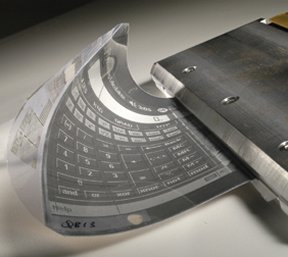Flexible E-Paper: Plastic circuits drive paperlike displays
- More than 2 years ago
In a major step toward electronic paper that works like a computer monitor yet feels and behaves like a page of a book, researchers in the Netherlands have made electronic-ink displays on flexible plastic sheets.


A U.S. company developed the electronic ink over the past several years. “Just like your newspaper, you can see it in bright light, dim light, or from all angles,” says Michael McCreary of E Ink in Cambridge, Mass.
The ink consists of millions of microcapsules, each one containing white and black pigments of opposite charge (SN: 6/20/98, p. 396: http://www.sciencenews.org/sn_arc98/6_20_98/bob2.htm). When a certain voltage is applied, the white pigments rise to the surface and the black ones descend out of sight. An opposite voltage leads to black pigments on top. Each pixel in the display is controlled by its own silicon-based transistor.
Until now, glass substrates that contain all the circuitry needed to drive the pixels have made the displays seem like very thin monitors. However, researchers at Philips Research Laboratories in Eindhoven, the Netherlands, have figured out how to make the circuitry flexible and paper-thin. The result: a display that a person can bend, roll, and even drop without fear of breaking it.
To achieve this, the Philips team made transistors out of electrically conducting polymers instead of silicon. The researchers patterned all the circuitry, including the transistors, onto sheets of plastic 25 microns thick. In collaboration with E Ink, they laminated electronic ink to the plastic sheet, aligning the display pixels with the transistors. The researchers describe their work in the February Nature Materials.
“This is a significant step toward display systems on plastic,” says electrical engineer Ananth Dodabalapur of the University of Texas at Austin.
In a show of muscle, the Philips group has produced displays with close to 80,000 pixels, which the researchers claim are the largest and thinnest polymer electronics-based displays fabricated to date.
The researchers have made displays from electronic inks that can switch to a new frame of text or a new image only a few times each second. That’s too slow for video, which requires dozens of frames per second. Even so, says McCreary, “there is no fundamental reason why electronic ink will not be able to switch at video rates in the future.”
Flexible electronic-paper products should be on the market in the next couple of years, says Bas Van Rens, general manager of the group that will commercialize the new display technology for Philips. One such product could be a display that rolls into a pen and can be carried around in a shirt pocket. “Then, if you want to read your e-mail or browse the Internet, you pull out the pen and roll out the display,” he says.
****************
If you have a comment on this article that you would like considered for publication in Science News, send it to editors@sciencenews.org. Please include your name and location.
To subscribe to Science News (print), go to https://www.kable.com/pub/scnw/
subServices.asp.
To sign up for the free weekly e-LETTER from Science News, go to http://www.sciencenews.org/subscribe_form.asp.







